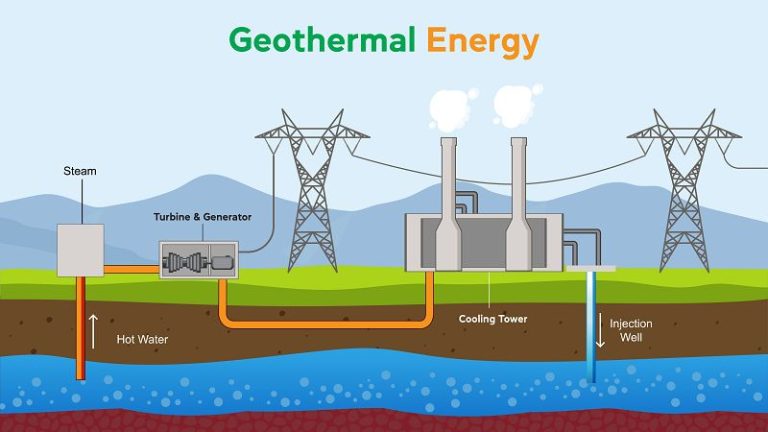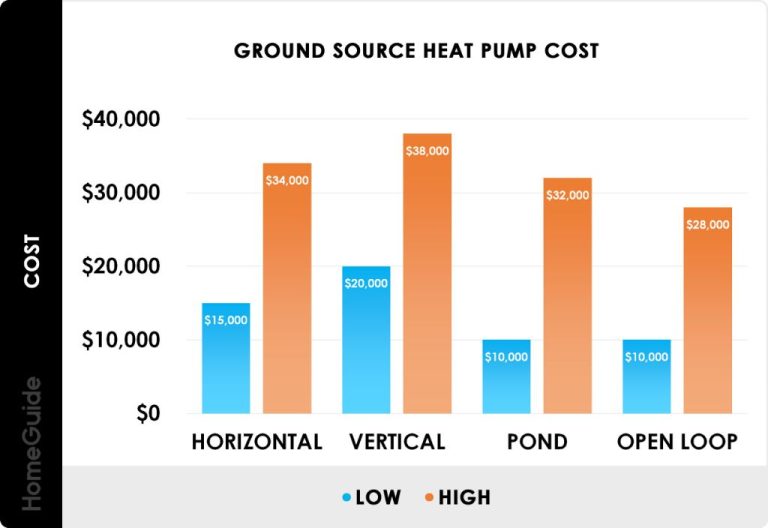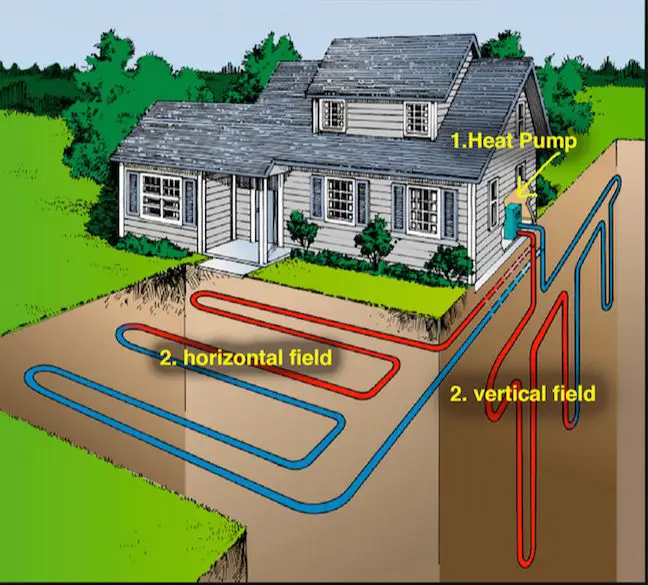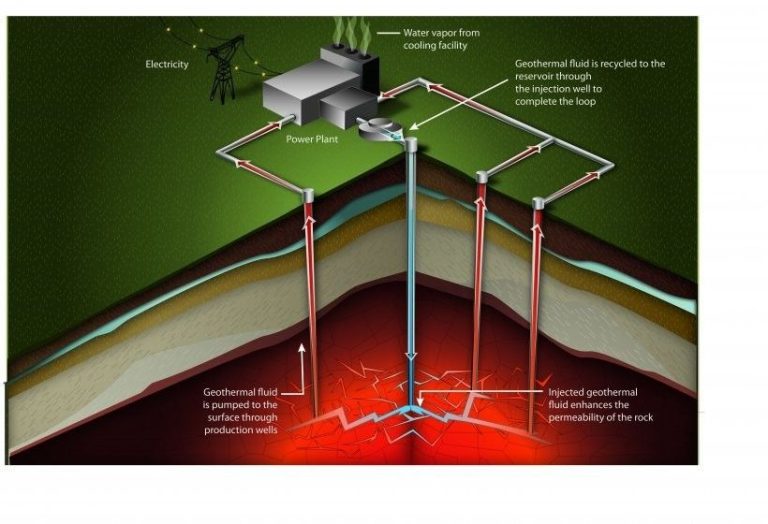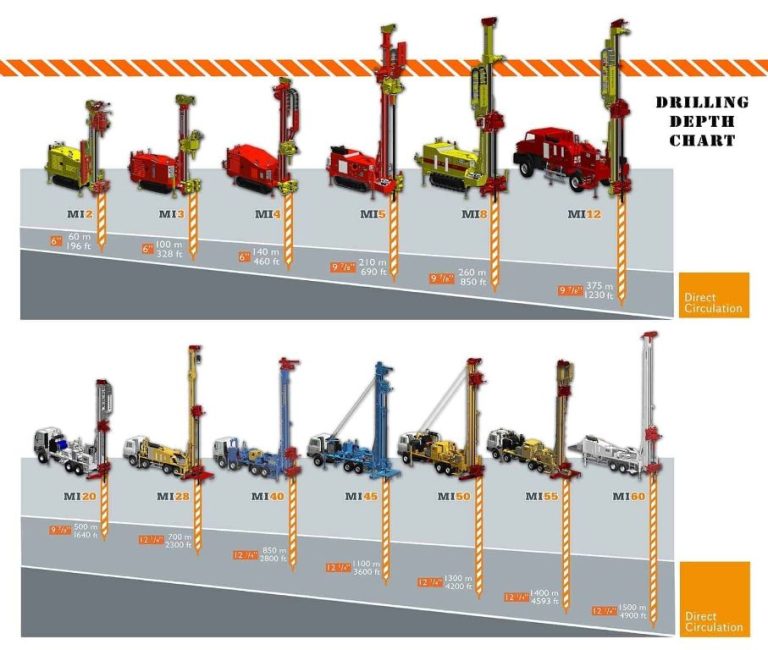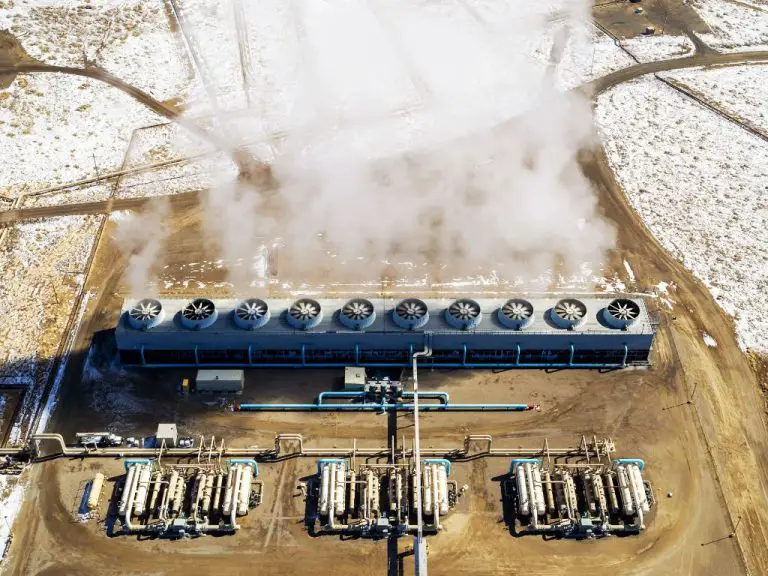What Energy Comes From Earth’S Heat?
What is Geothermal Energy?
Geothermal energy is heat energy generated and stored in the Earth. It is a renewable source of energy that utilizes the natural heat from the Earth’s core to produce electricity and provide heating and cooling.
The geothermal energy originates from the original formation of the planet, the ongoing radioactive decay of minerals, and the residual heat from solar energy absorbed by the Earth’s surface. This heat is conducted to the surface, warming rocks, soil, and any groundwater that may be present, as well as stored deeper in the earth.
Geothermal power plants utilize wells or pumps to bring steam or hot water from deep underground reservoirs to the surface to produce electricity. The steam rotates a turbine that activates a generator, which then produces electricity. Geothermal plants typically draw these resources from 3-10 kilometer deep wells.
In addition to electricity generation, geothermal energy can be used directly for heating homes, buildings, swimming pools, greenhouses, and industrial purposes. It can also be utilized for geothermal heat pumps in areas that lack natural hot water reservoirs closer to the surface.
History of Using Geothermal Energy
Humans have taken advantage of geothermal energy for thousands of years. Early civilizations, from the Romans to the Native Americans, used hot springs for bathing, cooking, and heating. Hot springs were considered sacred sites for their believed healing powers.
In the early 20th century, the first geothermal power plant was built in Italy in 1904. It produced 250 kilowatts of electricity. Development continued over the next few decades in Italy and other countries like New Zealand, Iceland, and the United States. The growth of geothermal expanded greatly starting in the 1960s and 1970s as oil prices increased and new technologies allowed access to greater depths.
Today, geothermal energy provides electricity to millions of households worldwide. Countries like the Philippines, Indonesia, and Kenya rely on geothermal for 20-30% of their energy needs. The uses of geothermal have expanded beyond electricity into applications like heating, agriculture, aquaculture and more. After a century of innovation, geothermal energy continues to grow as a renewable baseload resource.
Types of Geothermal Resources
There are three main types of geothermal resources that can be used to generate energy:
Hydrothermal Resources
Hydrothermal resources contain hot water or steam reservoirs in porous and permeable rock, typically located near volcanic regions. The heated water can naturally rise to the surface in the form of hot springs, geysers, or steam vents. Wells can be drilled into hydrothermal reservoirs to extract the heated water, which is brought to the surface and used to power turbines and generate electricity.
Geo-pressured Resources
Geo-pressured resources contain highly pressurized hot water trapped in deep unconventional reservoirs. While they have lower temperatures than hydrothermal resources, the high pressure allows the hot water to flow to the surface more easily when accessed by wells. The pressurized water can power turbine generators.
Hot Dry Rock Resources
Hot dry rock resources involve heating water by artificially pumped it into hot underground rock formations. The water passes through fractures and pores in the heated rock, absorbing energy before being circulated back to the surface where it converts into steam to drive turbines. This approach allows geothermal energy production even in areas without natural hydrothermal resources.
Uses of Geothermal Energy
Geothermal energy has a variety of applications that take advantage of the heat generated within the earth. Here are some of the main uses of this renewable energy resource:
Electricity Generation
Geothermal power plants use the heat from under the earth’s surface to produce steam to spin turbine generators and generate electricity. This is one of the most common uses of geothermal energy today. Geothermal power plants provide constant baseload power not subject to fluctuations in weather or climate.
Direct Heating/Cooling
Geothermal energy can directly heat and cool buildings and water. Pipes buried in the ground can circulate water or anti-freeze solutions that exchange heat with the earth to provide heating in the winter and cooling in the summer. Direct geothermal systems are used worldwide for heating homes, schools, aquaculture, and many other facilities.
Industrial Applications
The heat from geothermal resources can also be used in industrial applications that require temperatures between 77-302°F. Geothermal energy can heat water for Spas and pools, wash vegetables, pasteurize milk, dry crops, distill liquor, and extract minerals, among many other industrial uses.
Geographic Locations
Geothermal energy resources are abundant in certain geographic locations around the world. Some of the main areas known for geothermal activity and utilization include:
Western USA – The western United States, including Alaska, California, Nevada, Oregon, and Utah, has significant geothermal resources due to its location along tectonic plate boundaries. Major geothermal fields are found at The Geysers in California, Steamboat Springs in Nevada, and Roosevelt Hot Springs in Utah.
Iceland – Iceland is located on the Mid-Atlantic Ridge and harnessing geothermal resources provides over 25% of its electricity. Most of the high-temperature hydrothermal resources are located in the southwestern part of the country.
Philippines – As part of the Pacific Ring of Fire, the Philippines has many geothermal fields spread across the islands. Geothermal power provides about 18% of the country’s electricity generation.
Indonesia – Indonesia has over 40 geothermal sites located near volcanic belts across the many islands. With about 2,000 megawatts of installed capacity, geothermal supplies about 5% of Indonesia’s electricity needs.
There are significant geothermal resources located near tectonic plate boundaries, volcanic activity, and hot spots under the earth’s crust around the world. Countries like Kenya, Mexico, New Zealand, Italy, and Japan also utilize geothermal energy. The global distribution can be seen on geothermal resource maps.
Environmental Impact
Geothermal energy has several advantages compared to conventional fossil fuels in terms of environmental impact. Since geothermal plants do not burn fuel to generate electricity, they release little to no greenhouse gases. The steam and hot water used in geothermal plants come directly from the earth, rather than from combustion of fossil fuels.
Geothermal plants have very low emissions of sulfur dioxide, nitrogen oxides, and particulate matter. According to the U.S. Environmental Protection Agency, geothermal plants produce on average 97% fewer greenhouse gas emissions per kilowatt-hour than a coal-fired power plant. Geothermal electricity generation is nearly carbon-free.
Geothermal power plants also use very little land compared to other types of power plants. They need just enough space for the power plant and wells to pump up the hot water. This results in a small footprint and minimal land usage.
One environmental challenge with geothermal plants is managing induced seismicity from drilling and injecting water into wells. But by carefully monitoring injection rates and pressures, the risk of tremors can be minimized. Overall, geothermal energy has significant environmental benefits with minimal impacts.
Capacity and Generation
Geothermal power currently has an installed global capacity of around 14.5 gigawatts (GW), but capacity is expected to grow substantially in the coming years. The installed capacity has more than tripled since 2005. Countries with the largest installed capacity include the United States, Philippines, Indonesia, Turkey and New Zealand.
Projections estimate global geothermal capacity could reach over 60 GW by 2030 and over 200 GW by 2050. Growth will be driven by increased deployment across Asia, Africa, and Latin America. Particularly high growth is expected across countries located near the Pacific “Ring of Fire” volcanic belt.
In terms of cost, geothermal power plants are expensive to construct but have very low operating costs. The typical capital costs range from $2-4 million per installed megawatt of capacity, which is higher than solar or onshore wind. However, capacity factors for geothermal plants are much higher at over 90% compared to around 25% for solar and wind. This results in a levelized cost of electricity of $0.04-0.10 per kWh, competitive with fossil fuels.
Technology and Innovation
Advancements in technology are enabling expanded use of geothermal energy. One key technology is enhanced geothermal systems (EGS). EGS works by pumping water into hot dry rocks deep underground at high pressures, which creates fractures in the rocks, increasing permeability. The injected water circulates through the fractures, captures earth’s heat, and is pumped back to the surface where the heated water is used to generate electricity. EGS has the potential to dramatically increase geothermal capacity because it does not require finding naturally permeable reservoir rocks.
Another innovation involves coproducing geothermal energy from oil and gas wells. After extracting oil and gas, some wells can be converted into geothermal power plants by pumping water into the wells through an injection pipe, which gets heated as it travels through hot rocks, then rises back up through a second pipe and powers a turbine. This approach leverages existing wells and infrastructure. Several demonstration projects show promise for increasing geothermal capacity through coproduction.
Challenges
While geothermal energy has many benefits, there are some challenges to overcome in utilizing this renewable resource. Some of the main challenges include:
High upfront costs – Drilling geothermal wells and building power plants requires significant capital investment upfront before any energy can be generated and revenue earned. This can deter some investors and project developers.
Finding suitable reservoirs – Identifying deep underground reservoirs with adequate heat, fluid, and permeability can be difficult and risky. Not all areas have accessible geothermal resources.
Managing induced seismicity – If not managed carefully, injecting fluid into reservoirs can cause small earth tremors. This needs to be monitored and controlled through drilling practices and fluid management.
Future Outlook
The future of geothermal energy looks promising as it has enormous potential as a renewable energy source. Geothermal energy is expected to see continued growth and expansion in the coming decades.
Projections estimate geothermal power capacity could grow over 26 gigawatts globally by 2023. Areas with untapped potential like East Africa, Southeast Asia, and South America are prime locations for geothermal growth and development. With improved technology that enhances productivity of geothermal plants, the industry could potentially provide over 10% of the nation’s electricity needs by 2050.
Geothermal energy has a critical role to play in the renewable energy transition away from fossil fuels. As a clean, sustainable baseload energy source, geothermal can provide constant power generation unlike intermittent sources like wind and solar. With geothermal able to operate 24/7, it serves as a reliable backbone that complements other renewables. Its unique advantages make geothermal an important part of a diversified, low-carbon energy mix.
More investment and supportive policies are needed to realize geothermal’s full potential. But the industry shows promising signs of accelerated growth and innovation. With its environmental benefits, untapped potential and ability to produce constant reliable power, geothermal has a key role in building a sustainable energy future.

